The Effect of Basalt Fiber on Mechanical, Microstructural, and High-Temperature Properties of Fly Ash-Based and Basalt Powder Waste-Filled Sustainable Geopolymer Mortar
Abstract
:1. Introduction
2. Materials and Methods
2.1. Materials
2.2. Mixing Procedure and Samples
2.3. Tests Conducted
2.3.1. Compressive Strength, Flexural Strength, and Ultrasonic Pulse Velocity (UPV) Tests
2.3.2. Charpy Impact Test
2.3.3. Capillary Water Absorption
2.3.4. High-Temperature Test
3. Results and Discussions
3.1. Compressive and Flexural Strength Results
3.2. Ultrasonic Pulse Velocity (UPV) Results
3.3. Charpy Impact Test Results
3.4. Water Absorption
3.5. High-Temperature Results
3.5.1. Weight Measurement Results
3.5.2. Compressive and Flexural Strength Results
3.5.3. Ultrasonic Pulse Velocity (UPV) Results
3.5.4. Visual Assessment of High-Temperature Test
3.5.5. SEM and EDS Analysis
4. Conclusions
- The study revealed that adding BF to fly ash-based geopolymer mortars improved compressive strength after 28 days. Compressive strength increased by 6.43%, 9.65%, and 11.94% for 4 BF, 8 BF, and 12 BF, respectively.
- BF greatly improved flexural strength. The inclusion of BF decreased the number of fractures during the flexural test by transferring the flexural load. Flexural strength increased by 7.72%, 25.512%, and 34.15% for 4 BF, 8 BF and 12 BF after 28 days. Additionally, in the 12 BF series, flexural strength increased 2.86 times larger than compressive strength. Thus, the addition of basalt increased flexural strength more than compressive strength.
- A good relationship was found between Charpy impact test results and BF content. It improved the Charpy impact test results of the geopolymer specimens after 28 days. As compared to series 0 BF, the Charpy impact test results improved by 78%, 109%, and 118% for series 4 BF, 8 BF, and 12 BF, respectively.
- The increase in basalt content of fly ash-based geopolymer mortars affected negatively by increasing the water absorption ability. This increase occurred because of the inclusion of BF, which improved pore connectivity at high volume fractions. Additionally, the water absorption coefficients of 4 BF, 8 BF, and 12 BF samples increased by 9.04%, 10.55%, and 17.99%, respectively.
- The addition of BF slowed down the weight decreases. The 12 BF samples lost the least weight, while the 0 BF samples lost the most. After 800 °C, the weight loss percentages of 0 BF, 4 BF, 8 BF, 12 BF were 8.73%, 8.49%, 8.38%, and 8.17% respectively. At elevated temperatures, the interface bonds between the paste and aggregate deteriorate, resulting in weight loss. Consequently, the increase of high temperatures increased the weight loss percentages of geopolymer samples.
- The BF improved the compressive and flexural strengths of the samples after and before the high-temperature test. The increases of the compressive and flexural strengths of 4BF, 8BF, 12BF samples exposed to 800 °C were 9.01%, 12.79%, and 15.79% for compressive strength and 11.61%, 32.87%, and 44.69% for flexural strength, respectively compared to 0 BF samples. Thus, the high-temperature effect reduced flexural strength more than compressive strength.
- BF inhibited high-temperature cracks and limited the damages. Thus, the increase in basalt content decreased the damage degrees of fly ash-based geopolymer mortar samples. After the high-temperature test, the damage degrees of samples ranged from 3.69 to 17.42% for 12 BF samples. Additionally, the damage degrees of the samples exposed to high-temperature effects increased proportionally with the increase in high temperatures.
- The color of the samples and BF exposed to 200 °C and 400 °C did not change significantly compared to the samples exposed to 20 °C. Additionally, the samples exposed to 600 °C and 800 °C turned from gray to brown. Dehydration also affected the compactness of the geopolymer samples exposed to 600–800 °C.
- After 400 °C, 12 BF samples developed microcracks and became less compact than the 12 BF samples exposed to 200 °C. In addition, the Si/Al ratio of 12 BF samples exposed to 800 °C decreased compared to 12 BF samples exposed to 20 °C. After exposure to 600 °C and 800 °C, the samples’ evaporation rate and water loss rise, resulting in structural deterioration.
Author Contributions
Funding
Institutional Review Board Statement
Informed Consent Statement
Data Availability Statement
Conflicts of Interest
References
- Benhelal, E.; Zahedi, G.; Shamsaei, E.; Bahadori, A. Global strategies and potentials to curb CO2 emissions in cement industry. J. Clean. Prod. 2013, 51, 142–161. [Google Scholar] [CrossRef]
- Wang, J.; Mu, M.; Liu, Y. Recycled cement. Constr. Build. Mater. 2018, 190, 1124–1132. [Google Scholar] [CrossRef]
- Ma, C.-K.; Awang, A.Z.; Omar, W. Structural and material performance of geopolymer concrete: A review. Constr. Build. Mater. 2018, 186, 90–102. [Google Scholar] [CrossRef]
- Ai, T.; Zhong, D.; Zhang, Y.; Zong, J.; Yan, X.; Niu, Y. The Effect of Red Mud Content on the Compressive Strength of Geopolymers under Different Curing Systems. Buildings 2021, 11, 298. [Google Scholar] [CrossRef]
- Hattaf, R.; Aboulayt, A.; Samdi, A.; Lahlou, N.; Touhami, M.O.; Gomina, M.; Moussa, R. Reusing Geopolymer Waste from Matrices Based on Metakaolin or Fly Ash for the Manufacture of New Binder Geopolymeric Matrices. Sustainability 2021, 13, 70. [Google Scholar] [CrossRef]
- Nikoloutsopoulos, N.; Sotiropoulou, A.; Kakali, G.; Tsivilis, S. Physical and Mechanical Properties of Fly Ash Based Geopolymer Concrete Compared to Conventional Concrete. Buildings 2021, 11, 178. [Google Scholar] [CrossRef]
- Occhicone, A.; Vukčević, M.; Bosković, I.; Ferone, C. Red Mud-Blast Furnace Slag-Based Alkali-Activated Materials. Sustainability 2021, 13, 1298. [Google Scholar] [CrossRef]
- Tammam, Y.; Uysal, M.; Canpolat, O. Effects of alternative ecological fillers on the mechanical, durability, and microstructure of fly ash-based geopolymer mortar. Eur. J. Environ. Civ. Eng. 2021, 1–24. [Google Scholar] [CrossRef]
- Çelikten, S.; Atabey, İ. The effects of water content and thermal curing time on physical and mechanical properties of waste basalt powder-based geopolymer mortars. Ömer Halisdemir Univ. J. Eng. Sci. 2020, 10, 328–332. [Google Scholar] [CrossRef]
- Assaedi, H.; Alomayri, T.; Shaikh, F.U.A.; Low, I.-M. Characterisation of mechanical and thermal properties in flax fabric reinforced geopolymer composites. J. Adv. Ceram. 2015, 4, 272–281. [Google Scholar] [CrossRef] [Green Version]
- Shen, D.; Liu, X.; Li, Q.; Sun, L.; Wang, W. Early-age behavior and cracking resistance of high-strength concrete reinforced with Dramix 3D steel fiber. Constr. Build. Mater. 2019, 196, 307–316. [Google Scholar] [CrossRef]
- Vairavan, M.; Pandian, A.; Manikandan, V.; Jappes, T.W.; Uthayakumar, M. Effect of fibre length and fibre content on mechanical properties of short basalt fibre reinforced polymer matrix composites. Mater. Phys. Mech. 2013, 16, 107–117. [Google Scholar]
- Zhang, P.; Gao, Z.; Wang, J.; Wang, K. Numerical modeling of rebar-matrix bond behaviors of nano-SiO2 and PVA fiber reinforced geopolymer composites. Ceram. Int. 2021, 47, 11727–11737. [Google Scholar] [CrossRef]
- Zhang, P.; Wang, K.; Wang, J.; Guo, J.; Hu, S.; Ling, Y. Mechanical properties and prediction of fracture parameters of geopolymer/alkali-activated mortar modified with PVA fiber and nano-SiO2. Ceram. Int. 2020, 46, 20027–20037. [Google Scholar] [CrossRef]
- Zhang, P.; Wang, K.; Wang, J.; Guo, J.; Ling, Y. Macroscopic and microscopic analyses on mechanical performance of metakaolin/fly ash based geopolymer mortar. J. Clean. Prod. 2021, 294, 126193. [Google Scholar] [CrossRef]
- Zhang, P.; Zheng, Y.; Wang, K.; Zhang, J. A review on properties of fresh and hardened geopolymer mortar. Compos. Part B Eng. 2018, 152, 79–95. [Google Scholar] [CrossRef]
- Fiore, V.; Scalici, T.; Di Bella, G.; Valenza, A. A review on basalt fibre and its composites. Compos. Part B Eng. 2015, 74, 74–94. [Google Scholar] [CrossRef]
- Girgin, Z.C.; Yıldırım, M.T. Usability of basalt fibres in fibre reinforced cement composites. Mater. Struct. 2016, 49, 3309–3319. [Google Scholar] [CrossRef]
- Du, Q.; Cai, C.; Lv, J.; Wu, J.; Pan, T.; Zhou, J. Experimental Investigation on the Mechanical Properties and Microstructure of Basalt Fiber Reinforced Engineered Cementitious Composite. Materials 2020, 13, 3796. [Google Scholar] [CrossRef] [PubMed]
- Girgin, Z.C. Effect of slag, nano clay and metakaolin on mechanical performance of basalt fibre cementitious composites. Constr. Build. Mater. 2018, 192, 70–84. [Google Scholar] [CrossRef]
- Sadrmomtazi, A.; Tahmouresi, B.; Saradar, A. Effects of silica fume on mechanical strength and microstructure of basalt fiber reinforced cementitious composites (BFRCC). Constr. Build. Mater. 2018, 162, 321–333. [Google Scholar] [CrossRef]
- Wang, Z.; Yu, Q.; Ao, Q.; Du, Q. Mechanical properties of engineered cementitious composite containing basalt fibre. FEB Fresenius Environ. Bull. 2020, 29, 1997. [Google Scholar]
- Zhang, N.; Zhou, J.; Ma, G.-W. Dynamic properties of strain-hardening cementitious composite reinforced with basalt and steel fibers. Int. J. Concr. Struct. Mater. 2020, 14, 44. [Google Scholar] [CrossRef]
- Ali, N.; Canpolat, O.; Aygörmez, Y.; Al-Mashhadani, M.M. Evaluation of the 12–24 mm basalt fibers and boron waste on reinforced metakaolin-based geopolymer. Constr. Build. Mater. 2020, 251, 118976. [Google Scholar] [CrossRef]
- Görhan, G.; Aslaner, R.; Şinik, O. The effect of curing on the properties of metakaolin and fly ash-based geopolymer paste. Compos. Part B Eng. 2016, 97, 329–335. [Google Scholar] [CrossRef]
- Rill, E.; Lowry, D.; Kriven, W. Properties of Basalt Fiber Reinforced Geopolymer Composites. In Strategic Materials and Computational Design: Ceramic Engineering and Science Proceedings; The American Ceramic Society: Westerville, OH, USA, 2010; pp. 57–67. [Google Scholar]
- Binici, H.; Aksogan, O. Durability of concrete made with natural granular granite, silica sand and powders of waste marble and basalt as fine aggregate. J. Build. Eng. 2018, 19, 109–121. [Google Scholar] [CrossRef]
- Özkan, Ş.; Çoban, Ö. The hybrid effects of basalt and PVA fiber on properties of a cementitious composite: Physical properties and non-destructive tests. Constr. Build. Mater. 2021, 312, 125292. [Google Scholar] [CrossRef]
- Kim, D.J.; Wille, K.; El-Tawil, S.; Naaman, A.E. Testing of cementitious materials under high-strain-rate tensile loading using elastic strain energy. J. Eng. Mech. 2011, 137, 268–275. [Google Scholar] [CrossRef]
- Ma, Y.; Zhu, B.; Tan, M. Properties of ceramic fiber reinforced cement composites. Cem. Concr. Res. 2005, 35, 296–300. [Google Scholar] [CrossRef]
- Wang, Y.; Hughes, P.; Niu, H.; Fan, Y. A new method to improve the properties of recycled aggregate concrete: Composite addition of basalt fiber and nano-silica. J. Clean. Prod. 2019, 236, 117602. [Google Scholar] [CrossRef]
- Şahin, F.; Uysal, M.; Canpolat, O.; Aygörmez, Y.; Cosgun, T.; Dehghanpour, H. Effect of basalt fiber on metakaolin-based geopolymer mortars containing rilem, basalt and recycled waste concrete aggregates. Constr. Build. Mater. 2021, 301, 124113. [Google Scholar] [CrossRef]
- He, P.; Jia, D.; Lin, T.; Wang, M.; Zhou, Y. Effects of high-temperature heat treatment on the mechanical properties of unidirectional carbon fiber reinforced geopolymer composites. Ceram. Int. 2010, 36, 1447–1453. [Google Scholar] [CrossRef]
- Kong, D.L.Y.; Sanjayan, J.G.; Sagoe-Crentsil, K. Comparative performance of geopolymers made with metakaolin and fly ash after exposure to elevated temperatures. Cem. Concr. Res. 2007, 37, 1583–1589. [Google Scholar] [CrossRef]
- Arslan, A.A.; Uysal, M.; Yılmaz, A.; Al-mashhadani, M.M.; Canpolat, O.; Şahin, F.; Aygörmez, Y. Influence of wetting-drying curing system on the performance of fiber reinforced metakaolin-based geopolymer composites. Constr. Build. Mater. 2019, 225, 909–926. [Google Scholar] [CrossRef]
- Aygörmez, Y.; Canpolat, O.; Al-mashhadani, M.M.; Uysal, M. Elevated temperature, freezing-thawing and wetting-drying effects on polypropylene fiber reinforced metakaolin based geopolymer composites. Constr. Build. Mater. 2020, 235, 117502. [Google Scholar] [CrossRef]
- Zhang, H.Y.; Kodur, V.; Wu, B.; Cao, L.; Qi, S.L. Comparative thermal and mechanical performance of geopolymers derived from metakaolin and fly ash. J. Mater. Civ. Eng. 2016, 28, 04015092. [Google Scholar] [CrossRef]
- Jiang, X.; Xiao, R.; Zhang, M.; Hu, W.; Bai, Y.; Huang, B. A laboratory investigation of steel to fly ash-based geopolymer paste bonding behavior after exposure to elevated temperatures. Constr. Build. Mater. 2020, 254, 119267. [Google Scholar] [CrossRef]
- Topçu, İ.B.; Karakurt, C. Properties of reinforced concrete steel rebars exposed to high temperatures. Res. Lett. Mater. Sci. 2008, 2008, 814137. [Google Scholar] [CrossRef] [Green Version]
- Singh, H.; Gupta, R. Cellulose fiber as bacteria-carrier in mortar: Self-healing quantification using UPV. J. Build. Eng. 2019, 28, 101090. [Google Scholar] [CrossRef]
- Celik, A.; Yilmaz, K.; Canpolat, O.; Al-mashhadani, M.M.; Aygörmez, Y.; Uysal, M. High-temperature behavior and mechanical characteristics of boron waste additive metakaolin based geopolymer composites reinforced with synthetic fibers. Constr. Build. Mater. 2018, 187, 1190–1203. [Google Scholar] [CrossRef]
- Xu, J.; Kang, A.; Wu, Z.; Xiao, P.; Gong, Y. Effect of high-calcium basalt fiber on the workability, mechanical properties and microstructure of slag-fly ash geopolymer grouting material. Constr. Build. Mater. 2021, 302, 124089. [Google Scholar] [CrossRef]
- Temuujin, J.; Minjigmaa, A.; Rickard, W.; Lee, M.; Williams, I.; Van Riessen, A. Fly ash based geopolymer thin coatings on metal substrates and its thermal evaluation. J. Hazard. Mater. 2010, 180, 748–752. [Google Scholar] [CrossRef] [PubMed]
- Zhang, Y.; Li, S.; Wang, Y.; Xu, D. Microstructural and strength evolutions of geopolymer composite reinforced by resin exposed to elevated temperature. J. Non-Cryst. Solids 2012, 358, 620–624. [Google Scholar] [CrossRef]
- Abdulkareem, O.A.; Mustafa Al Bakri, A.M.; Kamarudin, H.; Khairul Nizar, I.; Saif, A.A. Effects of elevated temperatures on the thermal behavior and mechanical performance of fly ash geopolymer paste, mortar and lightweight concrete. Constr. Build. Mater. 2014, 50, 377–387. [Google Scholar] [CrossRef]
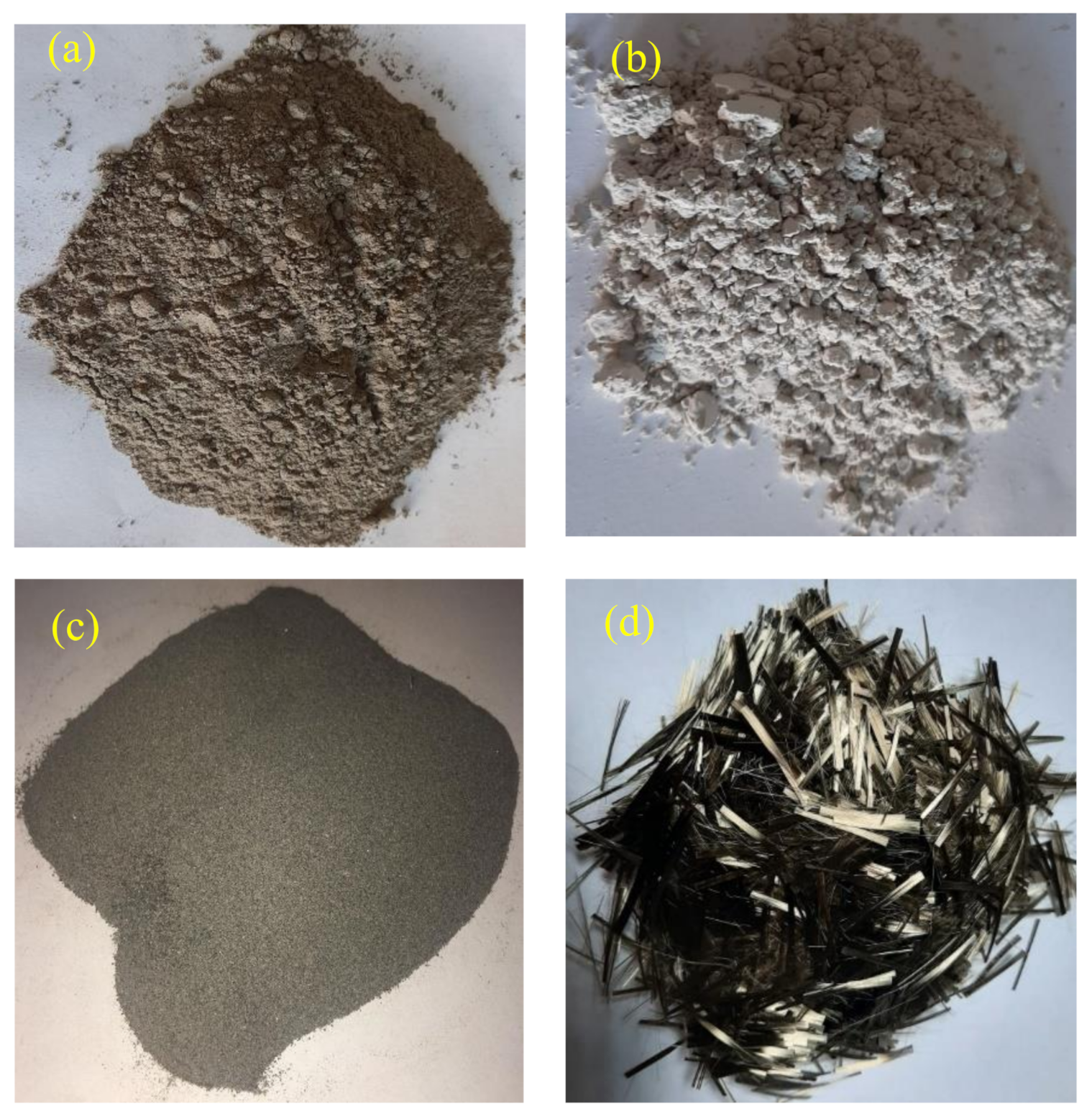

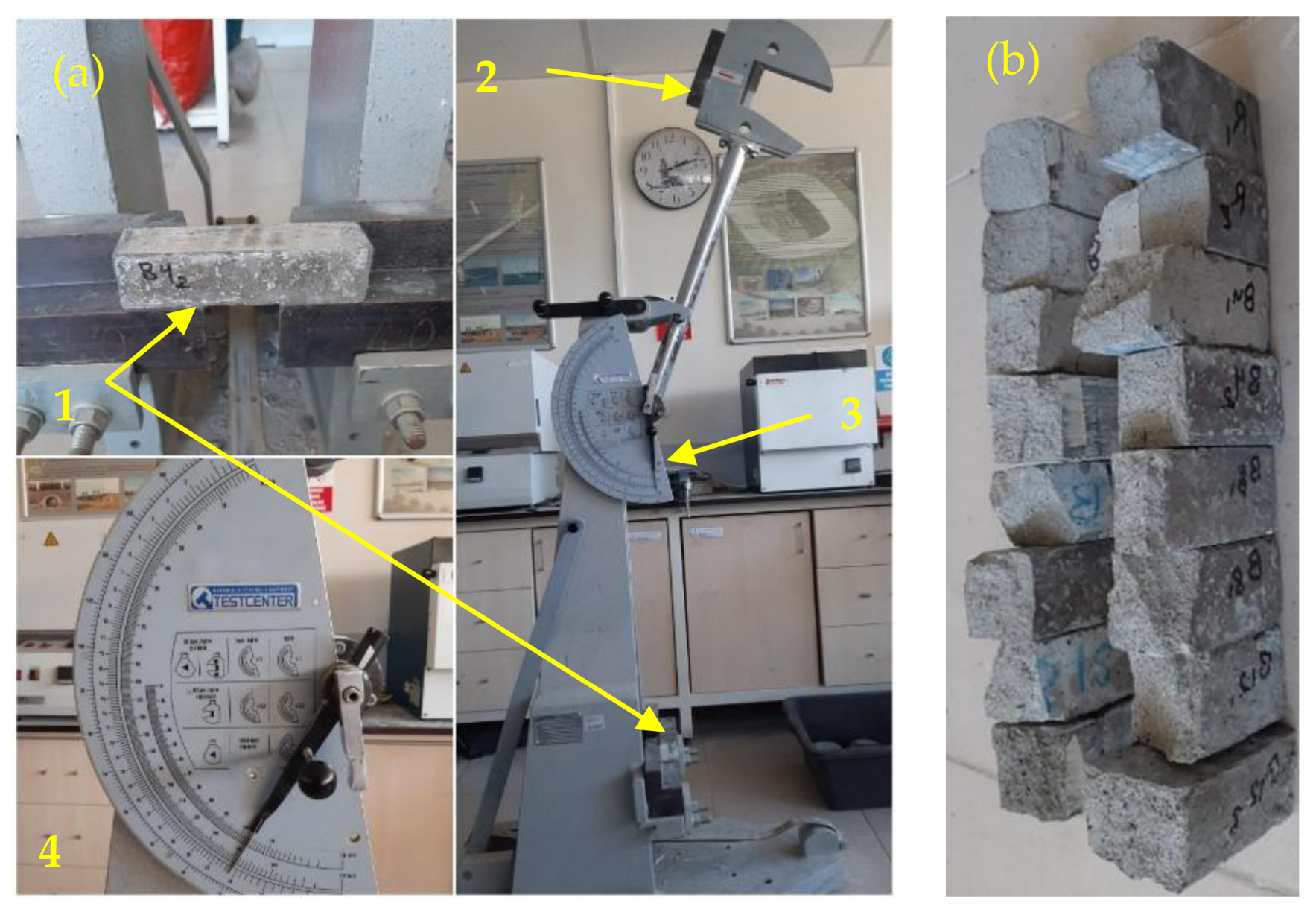
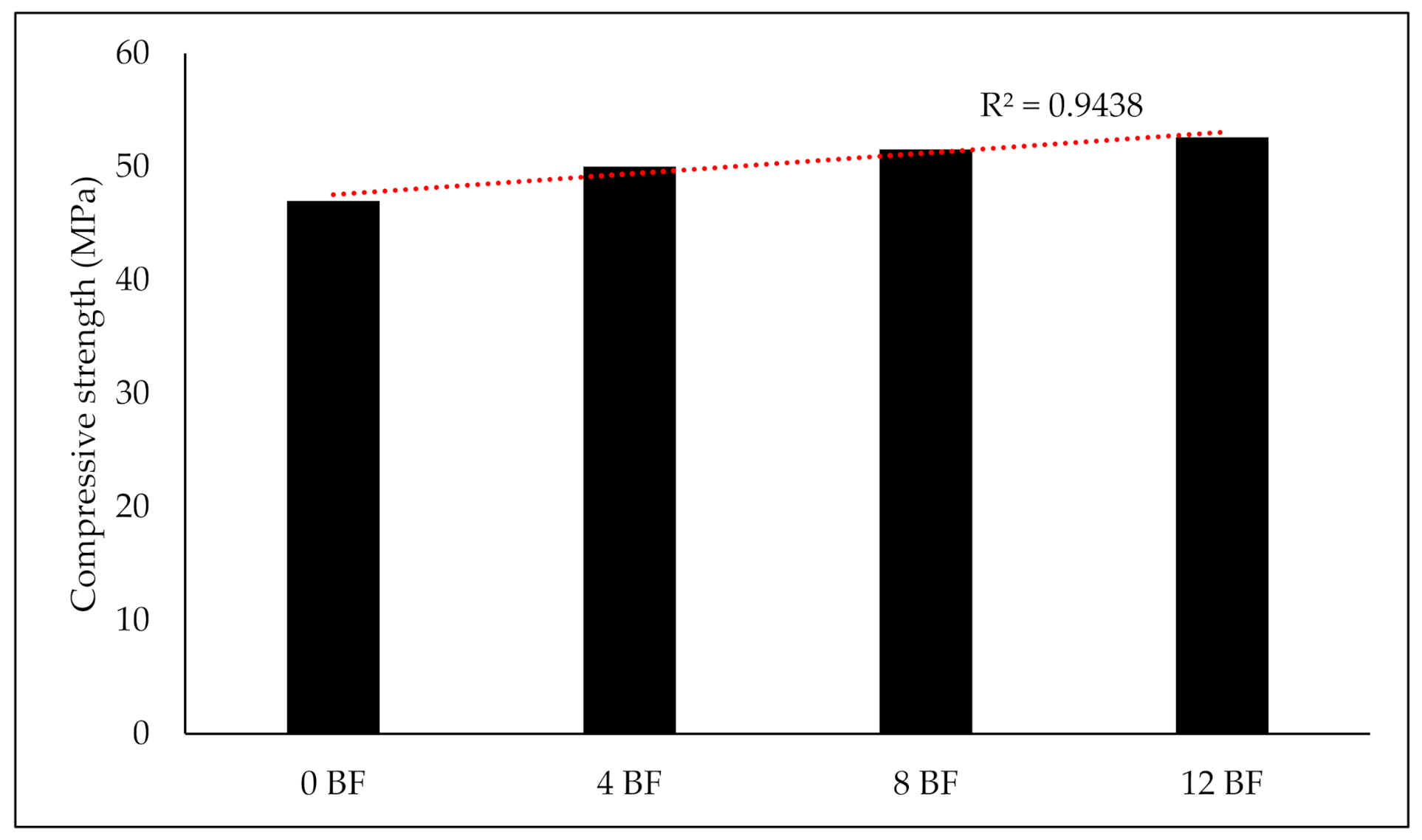

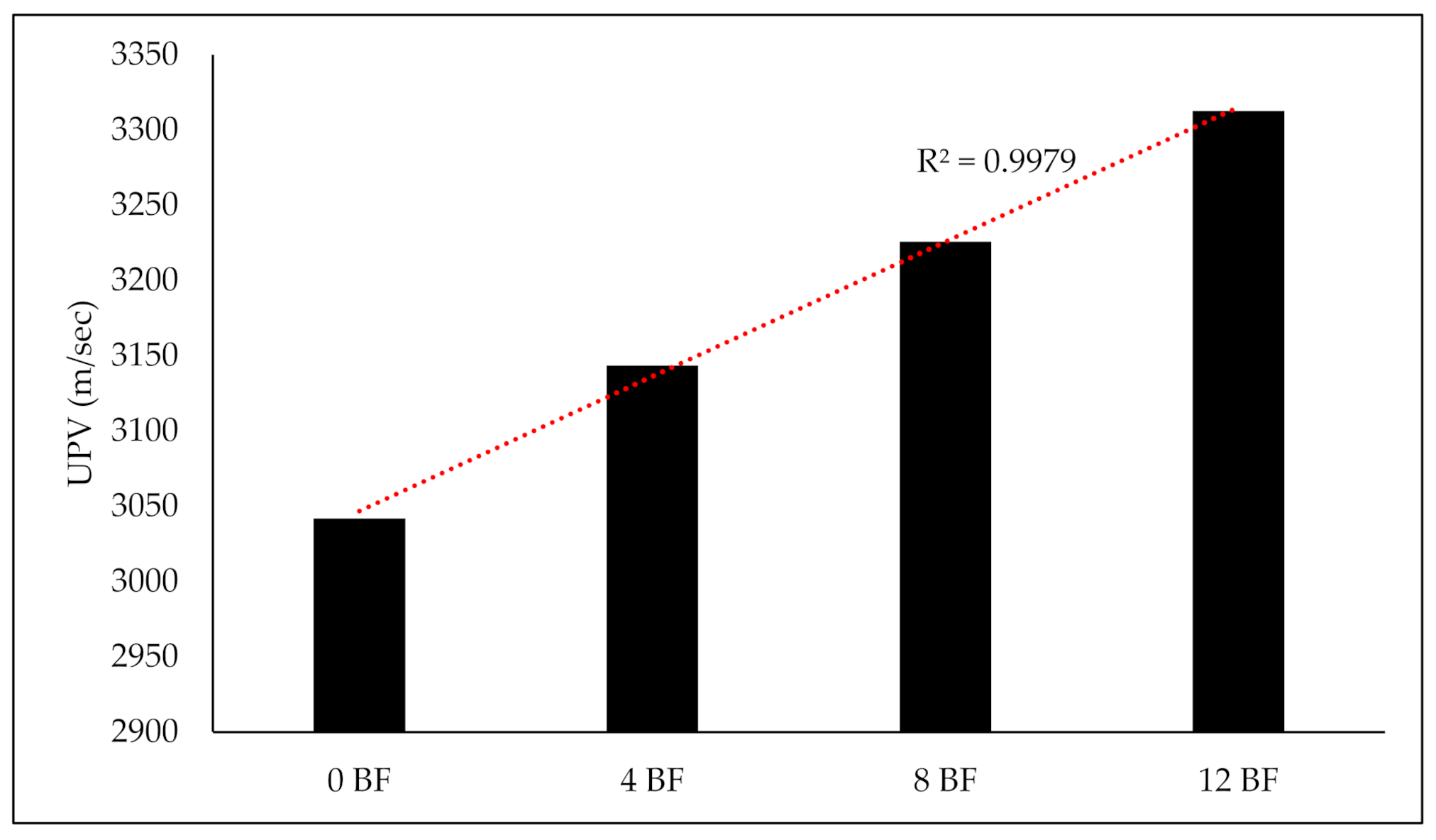
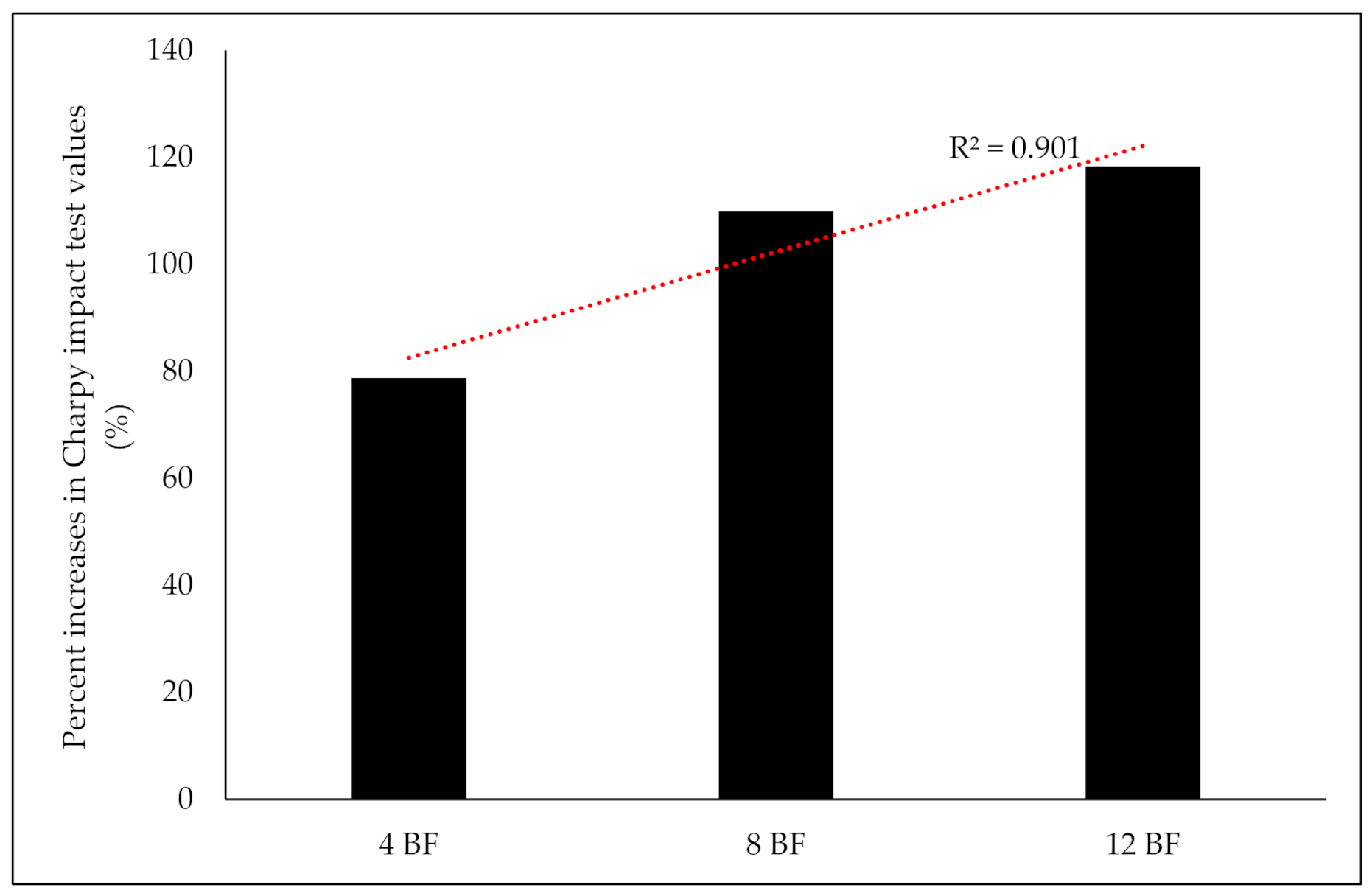
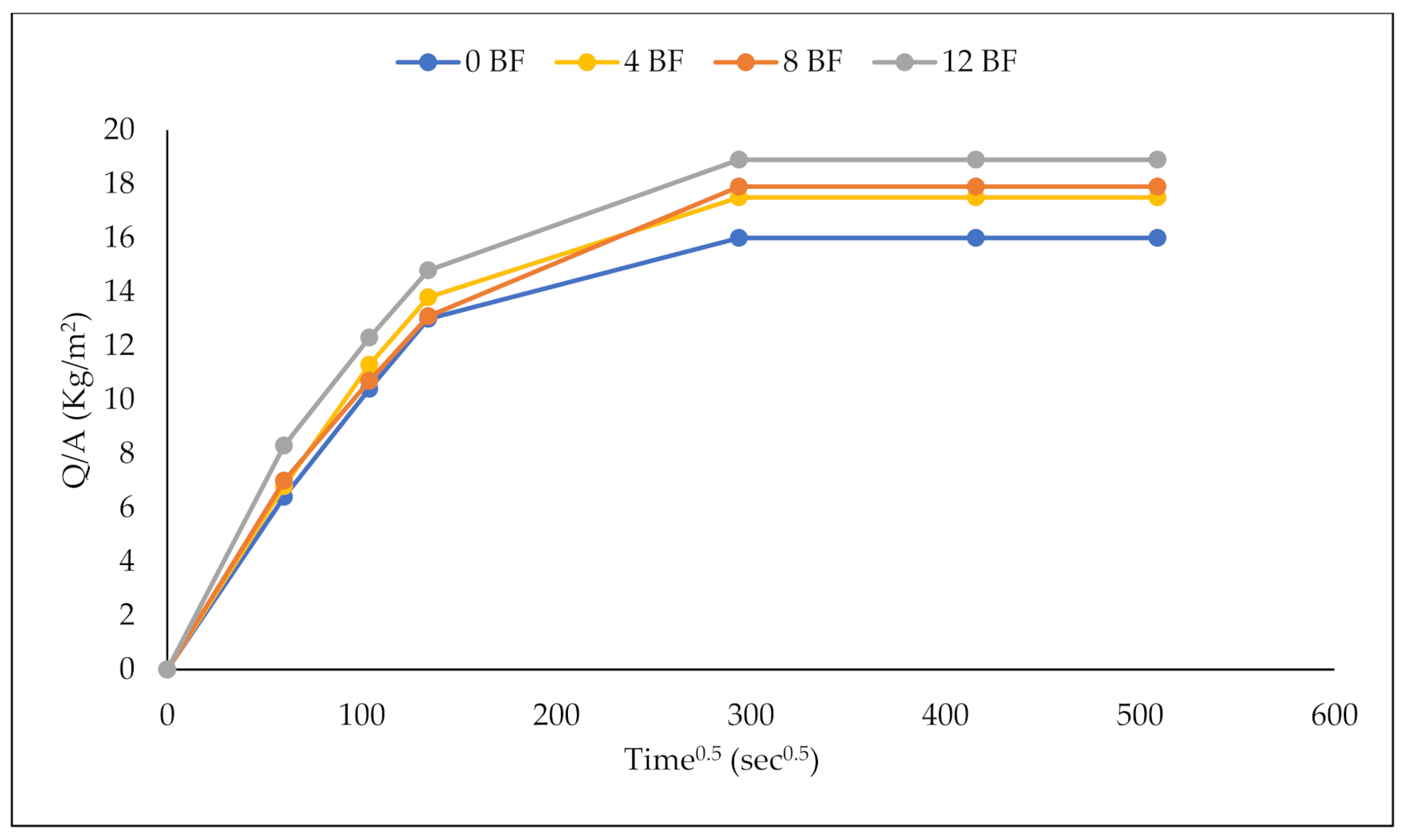
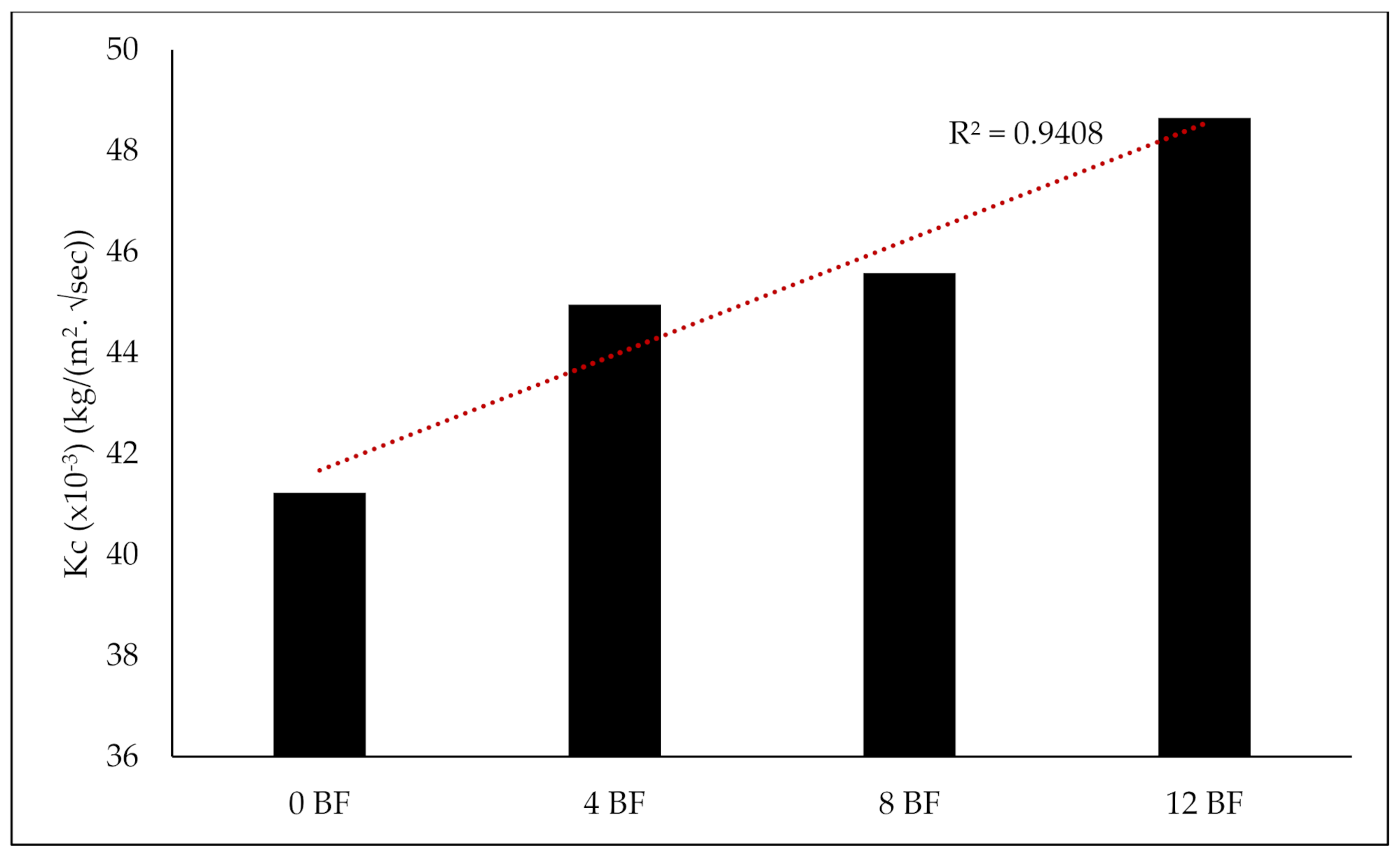

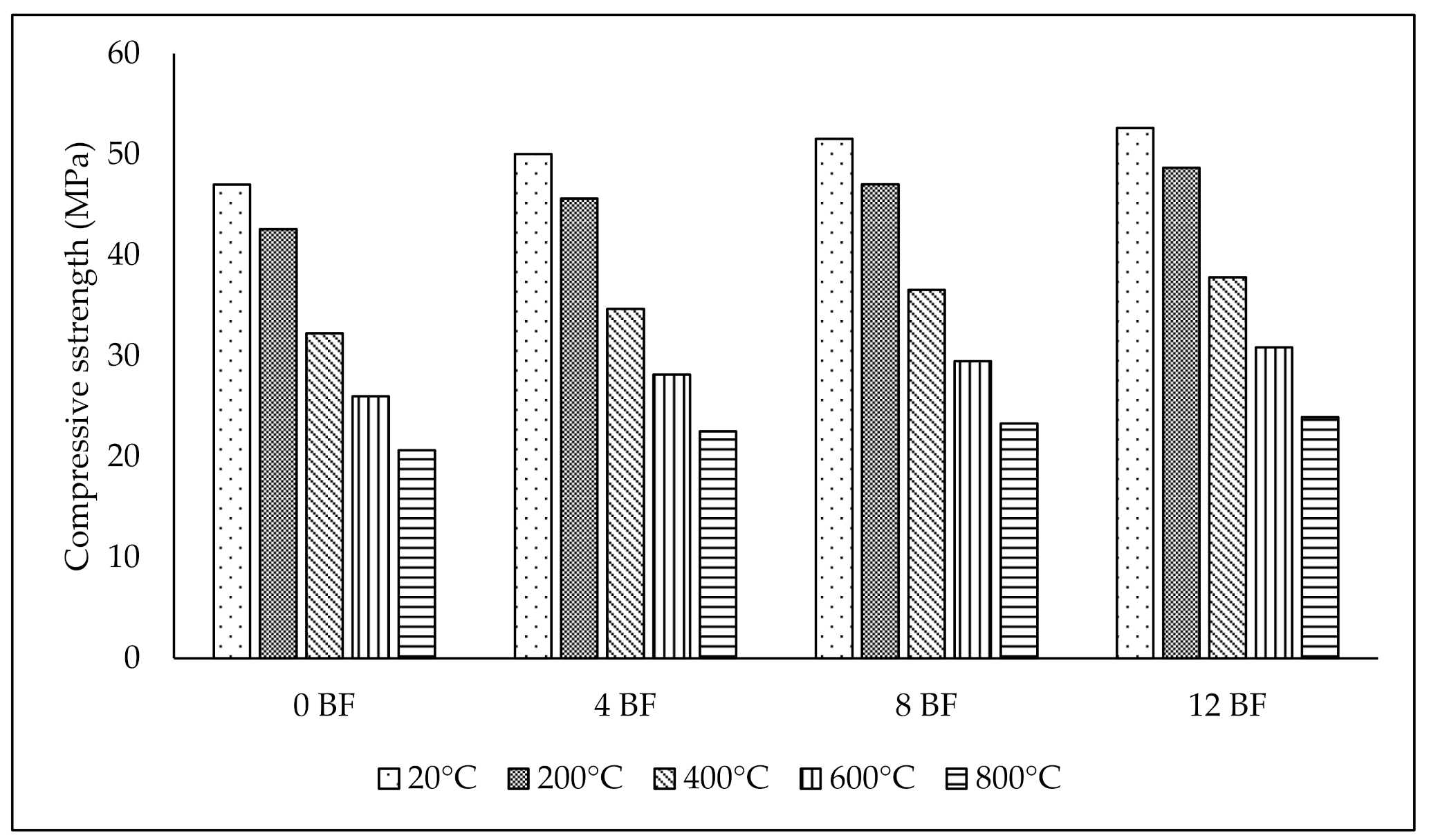
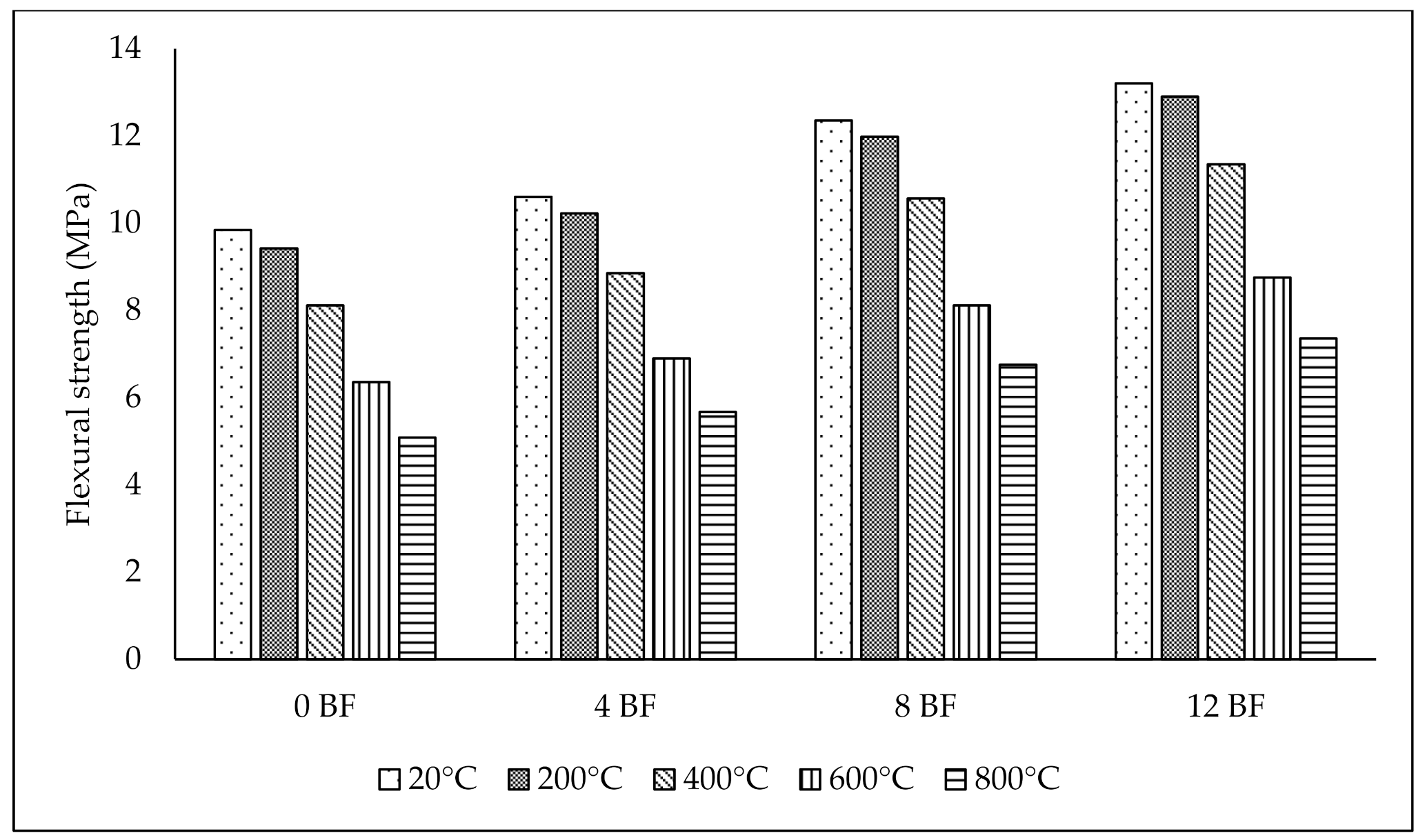

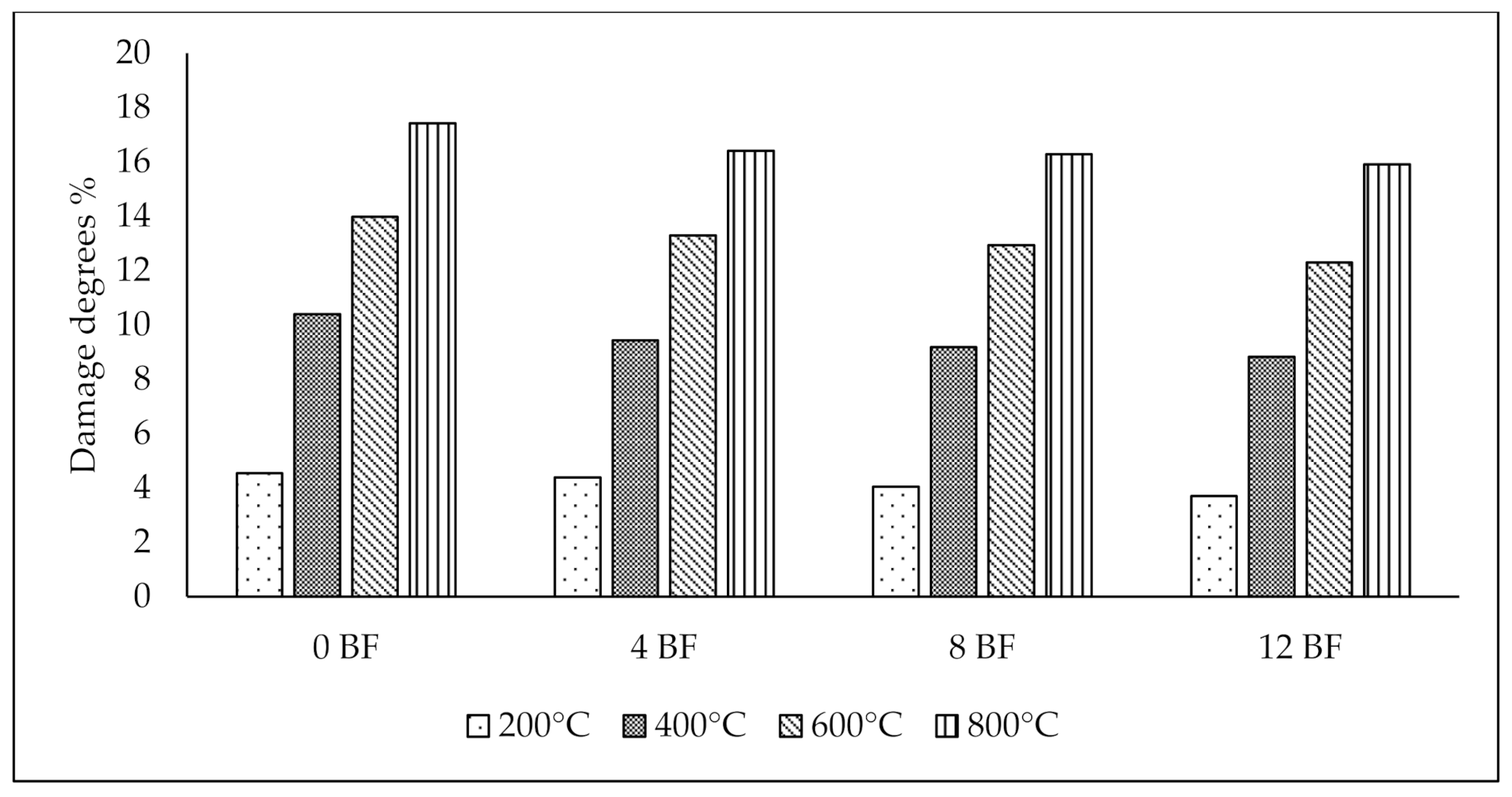
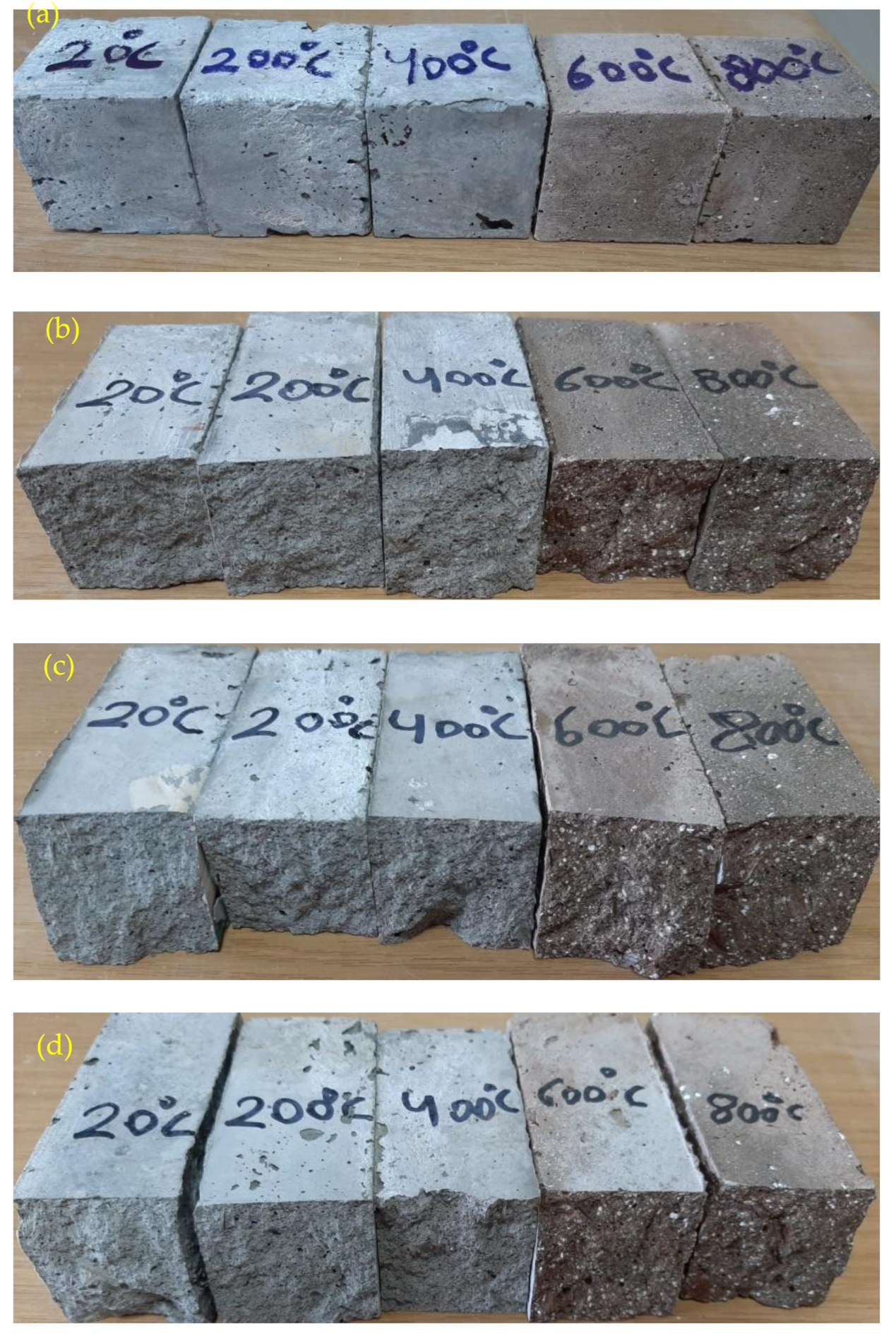
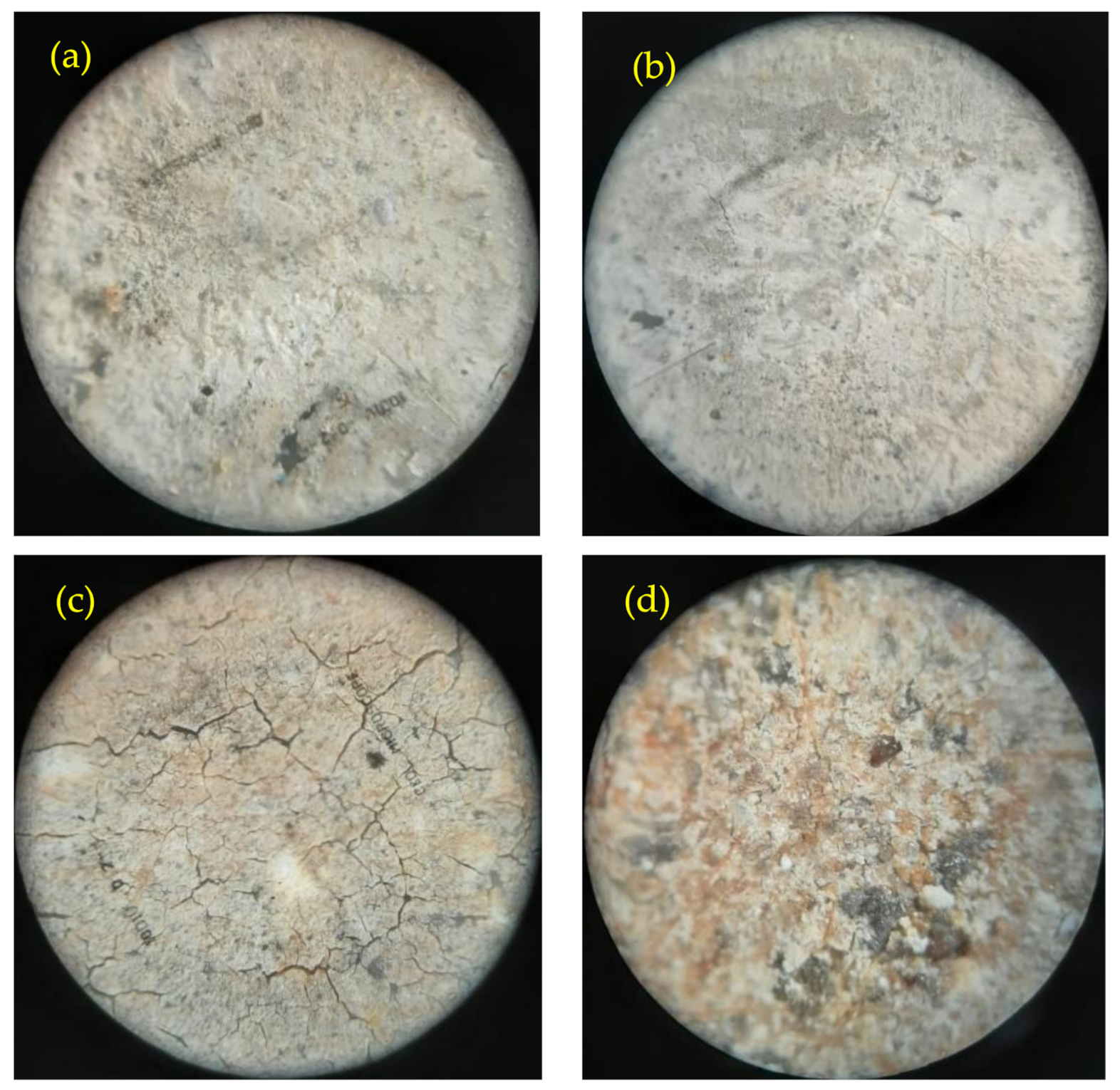
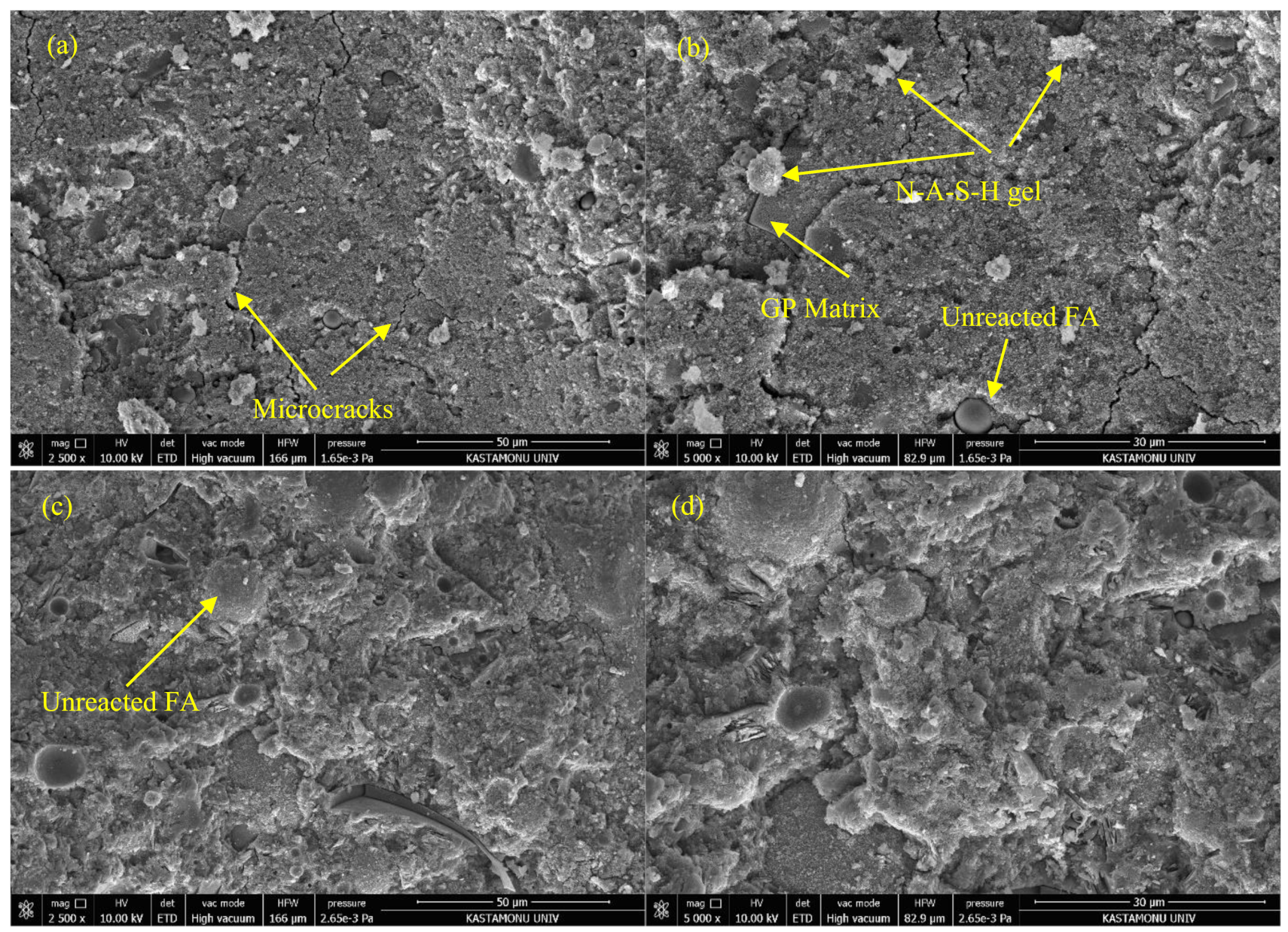
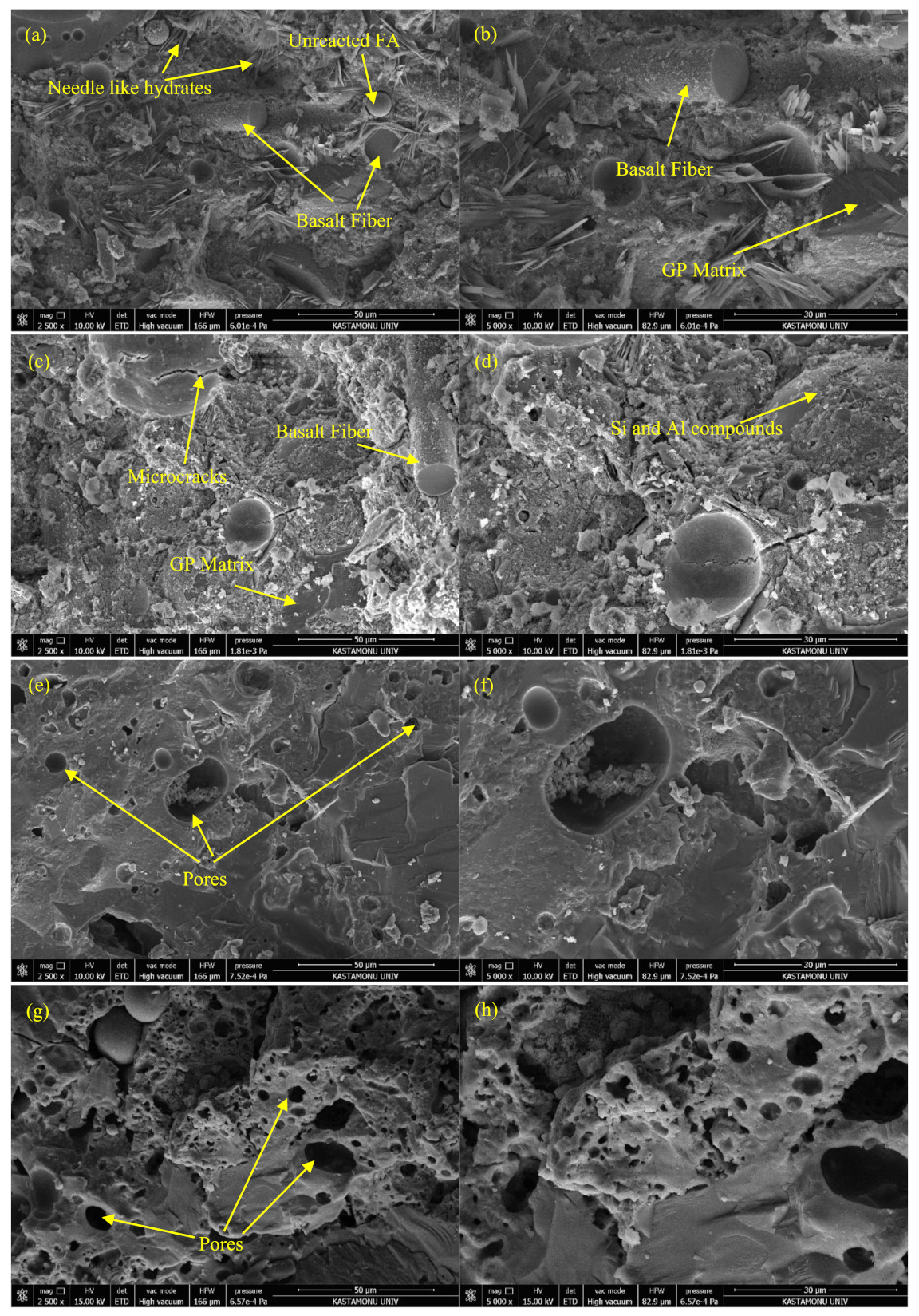
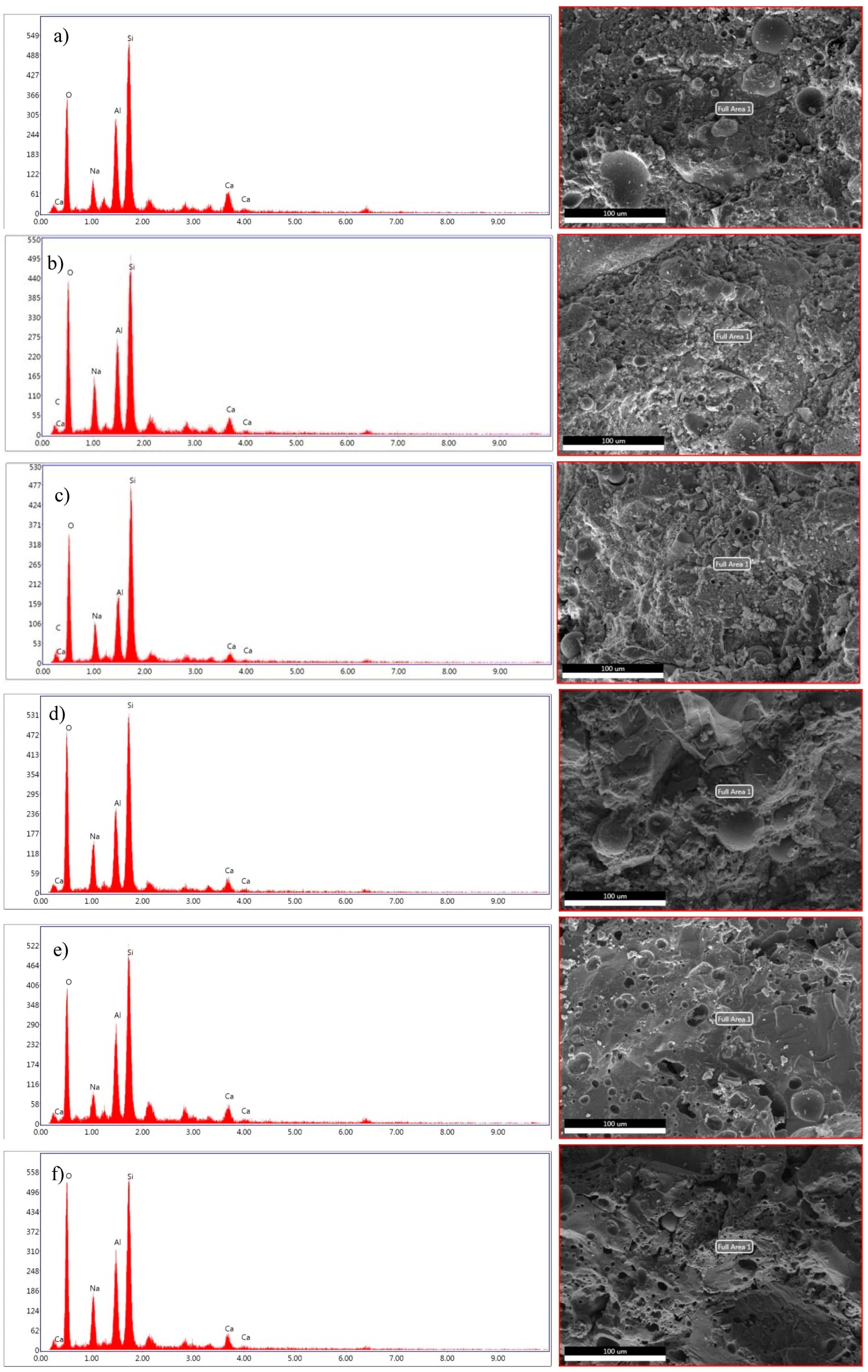
| Materials | SiO₂ | Al₂O₃ | Fe₂O₃ | TiO₂ | CaO | MnO | MgO | K₂O | Na₂O | SO₃ | Cl- | Loss of Ignition | Specific Gravity | Blaine (cm2/g) |
|---|---|---|---|---|---|---|---|---|---|---|---|---|---|---|
| FA (%) | 54.08 | 26.08 | 6.681 | - | 2.002 | - | 2.676 | - | 0.79 | 0.735 | 0.092 | 1.36 | 1.98 | 2571 |
| BP (%) | 56.9 | 17.6 | 8.1 | 0.9 | 8.15 | 0.1 | 2.1 | 1.9 | 3.8 | - | - | - | 2.76 | 6285 |
| S (%) | 40.55 | 12.83 | 1.1 | - | 35.58 | - | 5.87 | - | 0.79 | 0.18 | 0.0143 | 0.03 | 2.9 | 2612 |
| Na₂O (%) | SiO₂ (%) | Density (20 °C) (g/mL) | Fe (%) | Heavy Metals Value (pb) % |
|---|---|---|---|---|
| 9.68 | 26.12 | 1.367 | <0.005 | <0.005 |
| NaOH (g/kg) | Na₂CO₃ (g/kg) | SO4 | Fe | Cl | Al |
|---|---|---|---|---|---|
| ≥990 | ≤4 | ≤0.01 | ≤0.002 | ≤0.01 | ≤0.002 |
| Diameter (mm) | Length (mm) | Elasticity Module (GPa) | Nominal tensile Strength (MPa) | Specific Gravity |
|---|---|---|---|---|
| 0.02 | 12 | 88 | 4100 | 2.73 |
| Series | FA | Slag | SS | SH | BP | BF (Volume %) |
|---|---|---|---|---|---|---|
| 0 BF | 550 | 71 | 261 | 128 | 1100 | - |
| 4 BF | 550 | 71 | 261 | 128 | 1100 | 4 |
| 8 BF | 550 | 71 | 261 | 128 | 1100 | 8 |
| 12 BF | 550 | 71 | 261 | 128 | 1100 | 1.2 |
Publisher’s Note: MDPI stays neutral with regard to jurisdictional claims in published maps and institutional affiliations. |
© 2021 by the authors. Licensee MDPI, Basel, Switzerland. This article is an open access article distributed under the terms and conditions of the Creative Commons Attribution (CC BY) license (https://creativecommons.org/licenses/by/4.0/).
Share and Cite
Ziada, M.; Erdem, S.; Tammam, Y.; Kara, S.; Lezcano, R.A.G. The Effect of Basalt Fiber on Mechanical, Microstructural, and High-Temperature Properties of Fly Ash-Based and Basalt Powder Waste-Filled Sustainable Geopolymer Mortar. Sustainability 2021, 13, 12610. https://doi.org/10.3390/su132212610
Ziada M, Erdem S, Tammam Y, Kara S, Lezcano RAG. The Effect of Basalt Fiber on Mechanical, Microstructural, and High-Temperature Properties of Fly Ash-Based and Basalt Powder Waste-Filled Sustainable Geopolymer Mortar. Sustainability. 2021; 13(22):12610. https://doi.org/10.3390/su132212610
Chicago/Turabian StyleZiada, Mahmoud, Savaş Erdem, Yosra Tammam, Serenay Kara, and Roberto Alonso González Lezcano. 2021. "The Effect of Basalt Fiber on Mechanical, Microstructural, and High-Temperature Properties of Fly Ash-Based and Basalt Powder Waste-Filled Sustainable Geopolymer Mortar" Sustainability 13, no. 22: 12610. https://doi.org/10.3390/su132212610







